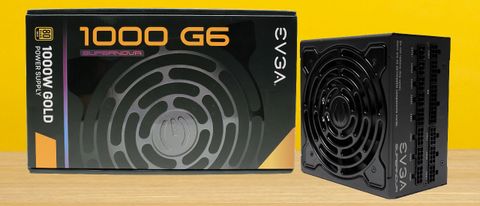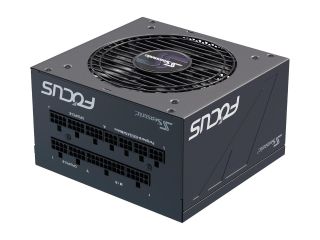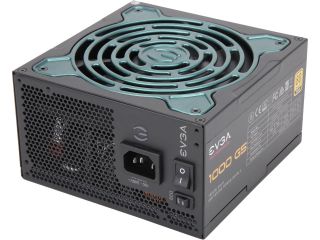Why you can trust Tom's Hardware
To learn more about our PSU tests and methodology, please check out How We Test Power Supply Units.
Primary Rails And 5VSB Load Regulation
The following charts show the main rails' voltage values recorded between a range of 40W up to the PSU's maximum specified load, along with the deviation (in percent). Tight regulation is an important consideration every time we review a power supply, because it facilitates constant voltage levels despite varying loads. Tight load regulation also, among other factors, improves the system’s stability, especially under overclocked conditions. At the same time, it applies less stress to the DC-DC converters that many system components utilize.

Results 1-8: Load Regulation







Load regulation is tight at 12V, satisfactory at 5V, and average at 5VSB. We would like to see a within 1% deviation at 3.3V.
Hold-Up Time
Put simply, hold-up time is the amount of time that the system can continue to run without shutting down or rebooting during a power interruption.

Results 9-12: Hold-Up Time



The hold-up time here is much longer than the 17ms we consider to be the bare minimum, and the power ok signal is accurate.
Inrush Current
Inrush current, or switch-on surge, refers to the maximum, instantaneous input current drawn by an electrical device when it is first turned on. A large enough inrush current can cause circuit breakers and fuses to trip. It can also damage switches, relays, and bridge rectifiers. As a result, the lower the inrush current of a PSU right as it is turned on, the better.

Results 13-14: Inrush Current

Inrush current is low with 115V input, but quite high with 230V.
Leakage Current
In layman's terms, leakage current is the unwanted transfer of energy from one circuit to another. In power supplies, it is the current flowing from the primary side to the ground or the chassis, which in the majority of cases is connected to the ground. For measuring leakage current, we use a GW Instek GPT-9904 electrical safety tester instrument.
The leakage current test is conducted at 110% of the DUT's rated voltage input (so for a 230-240V device, we should conduct the test with 253-264V input). The maximum acceptable limit of a leakage current is 3.5 mA and it is defined by the IEC-60950-1 regulation, ensuring that the current is low and will not harm any person coming in contact with the power supply's chassis.
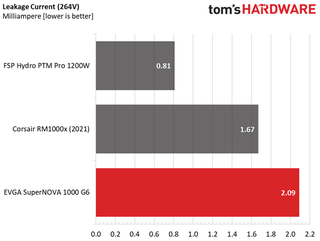
Leakage current exceeds 2mA. Still, it is much lower than the limit (3.5mA).
10-110% Load Tests
These tests reveal the PSU's load regulation and efficiency levels under high ambient temperatures. They also show how the fan speed profile behaves under increased operating temperatures.
| Test | 12V | 5V | 3.3V | 5VSB | DC/AC (Watts) | Efficiency | Fan Speed (RPM) | PSU Noise (dB[A]) | Temps (In/Out) | PF/AC Volts |
| 10% | 6.435A | 1.994A | 1.981A | 0.987A | 100.008 | 85.027% | 0 | <6.0 | 43.88°C | 0.966 |
| 12.184V | 5.016V | 3.332V | 5.069V | 117.619 | 40.28°C | 115.19V | ||||
| 20% | 13.877A | 2.994A | 2.976A | 1.187A | 199.965 | 89.663% | 0 | <6.0 | 45.21°C | 0.975 |
| 12.183V | 5.011V | 3.327V | 5.056V | 223.02 | 40.87°C | 115.12V | ||||
| 30% | 21.705A | 3.495A | 3.475A | 1.388A | 300.019 | 91.053% | 0 | <6.0 | 46.26°C | 0.981 |
| 12.161V | 5.008V | 3.324V | 5.044V | 329.499 | 41.28°C | 115.12V | ||||
| 40% | 29.489A | 3.998A | 3.975A | 1.59A | 399.833 | 91.168% | 658 | 15.4 | 42.03°C | 0.986 |
| 12.161V | 5.004V | 3.321V | 5.033V | 438.569 | 47.54°C | 115.12V | ||||
| 50% | 36.953A | 5.003A | 4.979A | 1.793A | 499.539 | 90.681% | 1482 | 40.7 | 42.11°C | 0.988 |
| 12.151V | 4.998V | 3.314V | 5.02V | 550.873 | 48.25°C | 115.12V | ||||
| 60% | 44.482A | 6.011A | 5.985A | 1.997A | 600.074 | 90.268% | 1483 | 40.7 | 42.84°C | 0.989 |
| 12.146V | 4.992V | 3.308V | 5.008V | 664.768 | 49.91°C | 115.11V | ||||
| 70% | 51.940A | 7.021A | 6.994A | 2.203A | 699.815 | 89.67% | 1481 | 40.7 | 43.59°C | 0.99 |
| 12.143V | 4.986V | 3.303V | 4.994V | 780.436 | 51.39°C | 115.11V | ||||
| 80% | 59.447A | 8.003A | 8.005A | 2.308A | 799.741 | 89.015% | 1484 | 40.7 | 43.72°C | 0.991 |
| 12.145V | 4.982V | 3.298V | 4.985V | 898.431 | 52.28°C | 115.11V | ||||
| 90% | 67.297A | 8.539A | 8.498A | 2.412A | 899.666 | 88.163% | 1850 | 46.4 | 44.2°C | 0.992 |
| 12.143V | 4.978V | 3.295V | 4.975V | 1020.457 | 53.63°C | 115.1V | ||||
| 100% | 74.925A | 9.048A | 9.023A | 3.029A | 999.692 | 87.21% | 1850 | 46.4 | 45.71°C | 0.992 |
| 12.146V | 4.975V | 3.292V | 4.954V | 1146.311 | 55.76°C | 115.09V | ||||
| 110% | 82.480A | 10.062A | 10.133A | 3.034A | 1100.312 | 86.203% | 1853 | 46.5 | 46.93°C | 0.993 |
| 12.148V | 4.97V | 3.286V | 4.945V | 1276.423 | 57.76°C | 115.1V | ||||
| CL1 | 0.115A | 15.088A | 15.106A | 0A | 126.316 | 81.409% | 1490 | 40.9 | 42.11°C | 0.982 |
| 12.208V | 4.991V | 3.283V | 5.069V | 155.163 | 48.64°C | 115.18V | ||||
| CL2 | 0.115A | 25.112A | 0A | 0A | 126.4 | 79.477% | 1838 | 46.2 | 43.56°C | 0.98 |
| 12.197V | 4.978V | 3.33V | 5.082V | 159.04 | 50.64°C | 115.18V | ||||
| CL3 | 0.115A | 0A | 25.342A | 0A | 83.897 | 72.862% | 1837 | 46.2 | 44.53°C | 0.964 |
| 12.186V | 5.017V | 3.256V | 5.067V | 115.144 | 52.52°C | 115.19V | ||||
| CL4 | 82.450A | 0A | 0A | 0.001A | 1000.228 | 87.932% | 1847 | 46.4 | 45.63°C | 0.992 |
| 12.131V | 4.996V | 3.327V | 5.032V | 1137.5 | 54.51°C | 115.08V |
The passive operation lasts up to 30% load, and with 40% load, the PSU's fan spins at low RPM. In all other tests, the fan speed is high, and the same applies to noise output. Lastly, the PSU doesn't have a problem with high operating temperatures, even under overload conditions.
20-80W Load Tests
In the following tests, we measure the PSU's efficiency at loads significantly lower than 10% of its maximum capacity (the lowest load the 80 PLUS standard measures). This is important for representing when a PC is idle with power-saving features turned on.
| Test | 12V | 5V | 3.3V | 5VSB | DC/AC (Watts) | Efficiency | Fan Speed (RPM) | PSU Noise (dB[A]) | Temps (In/Out) | PF/AC Volts |
| 10W | 1.222A | 0.498A | 0.494A | 0.196A | 20.004 | 76.442% | 0 | <6.0 | 39.37°C | 0.617 |
| 12.148V | 5.023V | 3.339V | 5.093V | 26.169 | 37.07°C | 115.2V | ||||
| 20W | 2.690A | 0.697A | 0.692A | 0.295A | 40.002 | 80.941% | 0 | <6.0 | 40.84°C | 0.833 |
| 12.151V | 5.022V | 3.338V | 5.089V | 49.428 | 38.08°C | 115.23V | ||||
| 30W | 4.148A | 0.897A | 0.89A | 0.393A | 60.001 | 79.783% | 0 | <6.0 | 41.28°C | 0.92 |
| 12.182V | 5.02V | 3.337V | 5.085V | 75.205 | 38.93°C | 115.2V | ||||
| 40W | 5.608A | 1.096A | 1.088A | 0.492A | 79.958 | 82.868% | 0 | <6.0 | 42.61°C | 0.952 |
| 12.185V | 5.018V | 3.336V | 5.082V | 96.488 | 39.62°C | 115.21V |
Burst mode operation boosts efficiency during the first two tests, but there is an efficiency drop with a 60W load. Efficiency increases again at 80W. All in all, this platform is highly efficient at light loads.
2% or 10W Load Test
From July 2020, the ATX spec requires 70% and higher efficiency with 115V input. The applied load is only 10W for PSUs with 500W and lower capacities, while for stronger units, we dial 2% of their max-rated capacity.
| 12V | 5V | 3.3V | Standby Rail | DC/AC (Watts) | Efficiency | Fan Speed (RPM) | PSU Noise (dB[A]) | Temps (In/Out) | PF/AC Volts |
| 1.464A | 0.264A | 0.264A | 0.053A | 20.253 | 77.006% | 0 | <6.0 | 31.25°C | 0.628 |
| 12.139V | 5.022V | 3.338V | 5.096V | 26.301 | 28.26°C | 115.19V |
At 2%, load efficiency is sky-high!
Efficiency & Power Factor
Next, we plotted a chart showing the PSU's efficiency at low loads, and loads from 10 to 110% of its maximum rated capacity. The higher a PSU’s efficiency, the less energy goes wasted, leading to a reduced carbon footprint and lower electricity bills. The same goes for Power Factor.

Results 15-18: Efficiency





With normal loads, efficiency could be higher. Efficiency is satisfactory with light loads, though, and outstanding with super-light loads.
5VSB Efficiency
| Test # | 5VSB | DC/AC (Watts) | Efficiency | PF/AC Volts |
|---|---|---|---|---|
| 1 | 0.100A | 0.512 | 67.546% | 0.074 |
| 5.123V | 0.758 | 115.14V | ||
| 2 | 0.250A | 1.279 | 76.040% | 0.153 |
| 5.118V | 1.682 | 115.14V | ||
| 3 | 0.550A | 2.809 | 78.093% | 0.273 |
| 5.107V | 3.597 | 115.13V | ||
| 4 | 1.000A | 5.093 | 77.260% | 0.376 |
| 5.092V | 6.592 | 115.13V | ||
| 5 | 1.500A | 7.615 | 78.887% | 0.429 |
| 5.076V | 9.653 | 115.14V | ||
| 6 | 3.000A | 15.077 | 76.580% | 0.503 |
| 5.026V | 19.688 | 115.13V |

Results 19-20: 5VSB Efficiency

We would like to see a more efficient 5VSB rail.
Power Consumption In Idle And Standby
| Mode | 12V | 5V | 3.3V | 5VSB | Watts | PF/AC Volts |
|---|---|---|---|---|---|---|
| Idle | 12.087V | 4.928V | 3.313V | 4.929V | 8.148 | 0.458 |
| 115.2V | ||||||
| Standby | 0.172 | 0.017 | ||||
| 115.2V |

Results 21-22: Vampire Power

Vampire power is low with 115V but exceeds 0.1W with 230V. Still, it is much lower than the limit, 0.25W, but it would be nice to see a below 0.1W reading.
Fan RPM, Delta Temperature, And Output Noise
All results are obtained between an ambient temperature of 37 to 47 degrees Celsius (98.6 to 116.6 degrees Fahrenheit).
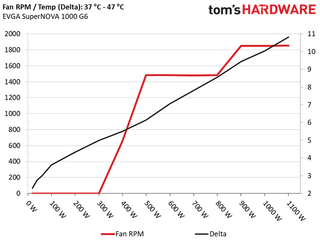
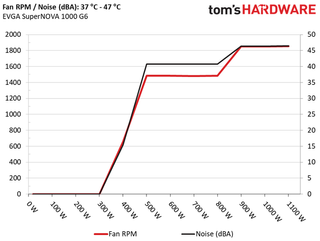
The fan speed profile gets highly aggressive at increased operating temperatures. The PCB is small for a 1000W PSU and densely populated, so the fan must rotate at high speeds to handle the heat load.
The following results were obtained at an ambient temperature of 30 to 32 degrees Celsius (86 to 89.6 degrees Fahrenheit).


The fan speed profile is quite loose at normal operating temperatures, keeping noise output in control. With up to 450W loads and with less than 80W on the minor rails, the PSU operates in passive mode if it is selected. The transition from 750W to higher loads could be smoother since the difference in noise output between moderate and high loads is vast.
MORE: Best Power Supplies
MORE: How We Test Power Supplies
MORE: All Power Supply Content
Current page: Load Regulation, Hold-Up Time, Inrush & Leakage Current, Efficiency and Noise
Prev Page Specifications and Part Analysis Next Page Protection Features, DC Power Sequencing, Cross-Load Tests and Infrared ImagesAris Mpitziopoulos is a Contributing Editor at Tom's Hardware US, covering PSUs.

Qualcomm teases Snapdragon X with no mention of Elite — news of second chip could be coming on April 24

Corsair's Elite 6500 ATX and Elite 2500 Micro-ATX get accent panel options — removable panels available in wood and aluminum

Alleged Zen 5 'Strix Halo' Mobile APU has more GPU cores than RX 7600 XT or PS5 — features monster RDNA 3.5 GPU with 40 compute units
-
Roland Of Gilead Hey there,Reply
Shouldn't the '1000w' in the Power specification chart be underneath the 12v rail? Also, are the amps correct? Specs from EVGA state 83.3a on the 12v rail, as opposed to 62.5? -
jsz031 Why is EVGA so scared to send you a GT or GA?Reply
I know they're worse, but I would like to see how they relatively perform according to your specific linear testing. -
werther595 Is the Super Flower models in the comparison charts the Leadex V Pro 1000W? I think that is their only current 1000W Gold unit. It was specifically named in the review of the Corsair 2021 PSU. Will you be reviewing the Super flower Leadex V Pro?Reply -
Lemkes Compared with the 1000 G3, the G6 model with a similar capacity has a depth of 140mm and a smaller size. A 135mm fan can hardly fit its chassis. As we said before, EVGA's G6 model uses an upgraded version of the Seasonic Focus platform.Reply
targetpayandbenefits.com -
LordTimothyDexter There's no way this review looked at the fan curve for this and must have taken the average dB data from somewhere else. The low average dB is EXTREMELY misleading for this PSU. It stay quiet up to a certain power draw and then the noise SKYROCKETS from it jumping to extremely high fan speeds, but if you were to take the mean dB across its load % it would show a low average dB. Very misleading, this thing gets louder than all the fans in my case combined -- 13 Arctic fans going at 1300-1500rpm are drowned out by the volume from this PSUReply
